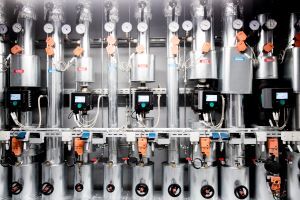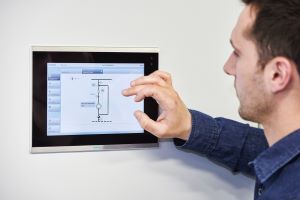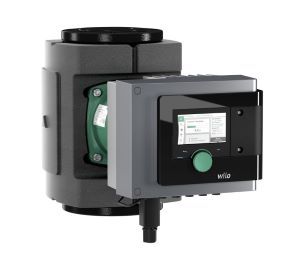ResmaP relies on the innovations of smart pumps of the latest generation in order to save valuable resources through new processes, forms of organization, and exchange and spare parts strategies. Innovative approaches, such as remote maintenance or remote-update capability, are used in a targeted manner to increase the service life of the products on the one hand, and to ensure that replaced pumps and components are recycled a high level of value preservation.

Heating pumps in the internet of things
Modern smart pumps make it possible to record and transmit valuable data on the condition, e.g. malfunctions, and the conditions of use of the product throughout the life cycle of the pump. This data can be used by service personnel and specialist technicians to simplify fault diagnosis and repair. In addition, this data can provide information for further product development. In ResmaP, the project consortium plans to use these new possibilities specifically to increase resource efficiency.
Whereas previous developments in the field of pump technology have focused mainly on energy efficiency in the utilization phase, ResmaP focuses on the area of material efficiency. For example, the technical possibilities of smart pumps should help to reduce resource consumption by extending the service life and targeted recycling of products and components considerably. To this end, the processes along the distribution chain, especially in maintenance and repair and in the return of products, are to be redesigned. This is intended to make optimum use of the resource efficiency potential inherent in smart pumps.

Closer cooperation
The use of resource efficiency potential through smart pumps requires two things in particular: firstly, precise knowledge of resource consumption over the entire product life cycle of the product and secondly, an increased willingness to cooperate between the actors. The skilled tradesmen and women in particular play a decisive role here. The skilled tradesman is usually the one who installs and maintains the heating pump and also decides when and whether a pump needs to be replaced or whether repair or replacement of certain components is sufficient.
In order to achieve the project objectives, the cooperation between pump manufacturers and skilled tradesmen is to be intensified in future. Other parties involved, such as wholesalers and facility management for larger residential units, are also to be involved accordingly. This requires a profound redesign of the processes and organisational structures between the actors. In order to achieve these goals, the project will test and evaluate new processes and organisational forms in maintenance and repair as well as in the return and dismantling of products and components - starting with a detailed investigation of resource consumption - from raw material extraction to recycling.

Results (Status June 2022)
The project consortium was able to identify approaches towards a increased (in terms of amount) and higher-quality circulation. Based on the information collected and processed throughout the pumps’ lifecycles insight can be gathered regarding circulation options for specific parts of the pump. A focus area in this regard was the recovery of spare parts from pumps. Depending on the error and affected component, a variety of different applications can be considered. For example, a relevant share of electronics components can be reused directly or refurbished for reuse.
Currently, work on the environmental assessment and potential assessment are being finalized in order to identify and quantify resource efficiency effects.
For the project’s stakeholder engagement, a phone survey with specialist craftsmen was conducted, followed by a workshop to validate and expand on the initial findings. 87 percent of companies asked said the circulation and reuse of parts from pumps is worth supporting. Generally, companies showed a high awareness for the topics of digitalization and resource efficiency.
Initial findings on the topic of processes were presented at the Electronics Goes Green conference in September 2020 and on the topic of decision-making systems at the Product Lifetimes and the Environment Conference (PLATE) in May 2021. Additional publications are currently being prepared.
Expected project results
The aim of the project is a new process of maintenance and repair and the replacement and recirculation of pumps, which has been tested in pilot trials. This new practice, initially tested by service technicians of the Wilo SE company, enables the extensive use of the resource efficiency potentials of smart pumps. In the course of the project, the results will be processed for external actors such as specialist tradesmen in a target-group-oriented manner in order to enable them to act in a resource-efficient manner in the future, which is reflected both in longer product lifetimes and in high-quality closed product cycles.
In order to achieve the project goals, Wilo SE, as a leading pump manufacturer, has joined forces with the Fraunhofer Institute for Material Flow and Logistics IML, whose focus is on recycling management and process design, and the TH Köln University of Applied Sciences with its focus on resource-side evaluation.
Publications
Project flyer of the funding measure (German / English) (March 2021)
The project flyers offer an insight into the contents and goals of the ReziProK projects and present first results in each case.
Project sheets of the funding measure (German) (August 2019)
The project sheets provide a brief overview of the individual projects and their goals.
Contributions to the ReziProK Transfer Conference in June 2022
Poster (German) (June 2022)
Presentation (German) (June 2022)
Contributions to the ReziProK Kick-off event in December 2019
Poster - in German (December 2019)
Presentation - in German (December 2019)
Picture credits: Wilo SE
